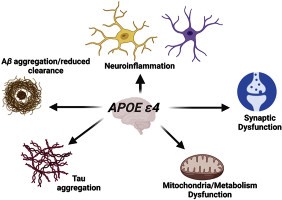Alzheimer’s disease, a neurodegenerative disorder affecting millions worldwide, has long been a subject of intense research and concern. While its etiology remains complex and multifaceted, recent studies have shed light on a distinct genetic form of Alzheimer’s associated with a specific gene variant known as apolipoprotein E4 (APOE4). In this blog post, we delve into the groundbreaking findings of a recent study that uncovers the significance of APOE4 homozygosity in Alzheimer’s development, its implications for early diagnosis and prevention, and the potential impact on future treatments.
Table of Contents
The APOE4 Gene Variant
A Key Player in Alzheimer’s Risk: For decades, researchers have recognized the APOE4 gene variant as a significant risk factor for late-onset Alzheimer’s disease. However, the recent study discussed in this post reveals a deeper connection between APOE4 and Alzheimer’s pathology. Individuals inheriting two copies of the APOE4 variant are now identified as virtually certain to develop Alzheimer’s, highlighting its role not just as a risk factor but as an underlying cause of the disease.
Understanding the Biological Mechanisms
The study’s comprehensive analysis, involving over 13,000 participants, provides crucial insights into the biological mechanisms underlying Alzheimer’s development in APOE4 homozygotes. By examining postmortem brain samples and biomarker data, researchers observed distinct patterns of Alzheimer’s pathology resembling those found in early-onset familial forms of the disease. These findings signify a shift in understanding Alzheimer’s as a spectrum of genetic conditions, with APOE4 homozygosity representing a distinct genetic form.
Early Detection and Prevention Strategies
One of the most significant implications of this research is the potential for early detection and personalized prevention strategies. Individuals with two copies of APOE4 exhibit elevated Alzheimer’s biomarker levels from as early as age 55, indicating a critical window for intervention. With advancements in biomarker-based diagnostics, clinicians may be able to identify at-risk individuals before the onset of clinical symptoms, paving the way for targeted preventive measures and interventions.
Reimagining Clinical Trials and Treatment Approaches
The recognition of APOE4 homozygosity as a genetic form of Alzheimer’s disease holds implications for clinical trial design and treatment development. As researchers increasingly view Alzheimer’s as a biologically-defined condition, reclassifying APOE4 homozygotes could lead to more tailored approaches in clinical research and drug development. Moreover, the identification of specific biomarker patterns associated with APOE4 homozygosity may inform the development of novel therapeutic interventions targeting early disease mechanisms.
Challenges and Future Directions
While the findings of this study represent a significant advancement in Alzheimer’s research, further investigations are needed to validate these findings across diverse populations. Additionally, the translation of research findings into clinical practice will require concerted efforts to develop scalable and accessible diagnostic tools and preventive interventions.
Conclusion
The identification of APOE4 homozygosity as a distinct genetic form of Alzheimer’s disease marks a paradigm shift in our understanding of this devastating condition. By elucidating the biological underpinnings of Alzheimer’s pathology in APOE4 homozygotes, this research opens new avenues for early detection, personalized prevention, and targeted treatment approaches. As we continue to unravel the complexities of Alzheimer’s disease, collaborative efforts between researchers, clinicians, and policymakers will be essential in translating scientific discoveries into tangible benefits for individuals at risk of developing this debilitating condition.

Your point of view caught my eye and was very interesting. Thanks. I have a question for you.